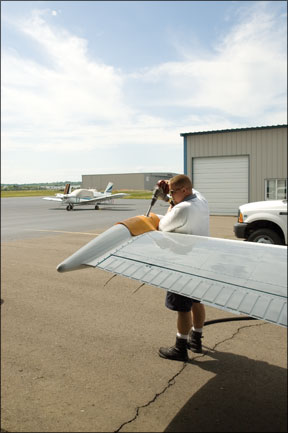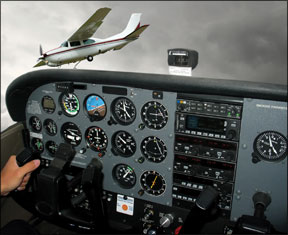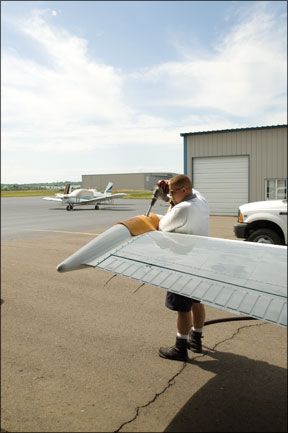Its strange (or not so strange) that I usually hear or read about some sort of related accident happening after I read an article in your magazine. The apparent cause of those accidents are almost exactly “the gotchas” discussed in the article. With that in mind, “Fuel Gotchas” (April 2007) hit very close to home. Our local flying club just lost a Cessna 172, apparently because the pilot ran out of fuel. A 40-knot headwind resulted in a four-plus hour flight from El Monte, Calif., to Stockton, Calif. This route usually takes less then 2.5 hours. Of course, the Skyhawk only had 38 usable gallons. Do the math. 233 The event, which involved a flight of two brothers-the other was flying a Piper Cherokee-was recorded both by ATC and the local news media. From the recording, one can hear the accompanying pilots disbelief when the Cessna ran out of fuel. Later, in the hospital, the Skyhawk pilot told club members he declined his brothers offer to stop for fuel. Sadly and in addition to endangering himself and others, the Skyhawk pilot trashed an aircraft club members all loved. It is too sad for all of us and just doesnt make any sense. James Bu Via e-mail More Fuelish I just dont get this. Why would any pilot elect to take off with less than full fuel, unless gross weight is an issue? Minor performance degradation is a small price to pay for certainty and peace of mind. John W. Ward Mamaroneck, N.Y. A couple of points. First, a pilots behavior in an airplane can affect people far beyond those he carries aloft or flies over. Second, we can think of several good reasons to take off without full tanks. Among them is fuel unavailability at the departure point. But, to us, the key is to know before leaving the ground how much fuel is aboard and how long it will take to fly the planned flight. If the plan isnt working-headwinds, for example-you land and get more fuel. Ultimately, “fuel exhaustion” as an accident cause is equivalent to a careless pilot who isnt paying attention. Missing the point I feel you missed a critical point in your March 2007 article about minimizing IFR and VFR traffic conflicts at uncontrolled airports (“Lurking In The Murk”). The Aeronautical Information Manual does indeed make the recommendation laid out in your sidebar, “What the FAA Says,” to broadcast your intentions, including “the type of approach being executed, your position, and when over the final approach fix inbound (non-precision approach) or when over the outer marker or fix used in lieu of the outer marker inbound (precision approach.” But most of this information merely clogs up the frequency and is meaningless to the VFR pilots you are trying to avoid. 288 Other pilots in the airport environment may have no knowledge of intersection names, approach fixes or outer markers. Indeed, VFR pilots are not trained on or expected to know any of that. When an inbound IFR pilot broadcasts a call like, “Cessna 1234 at SLIMY intersection, inbound GPS 30 approach,” they may as well be speaking Swahili-most VFR pilots wont have a clue where to look for them or what they intend to do. A much more useful radio call conveys position in a way that all pilots can understand-“five miles north, descending out of 2500 feet”-and a similar English-language description of intentions-“straight in, Runway 30.” And about those long straight-in IFR approaches: If theres VFR traffic in the pattern (and the weather is VMC), isnt it safer to make a standard pattern entry and join other traffic rather than coming from nowhere on a long final that VFR traffic probably wont be expecting or looking for? I see these sort of conflicts all the time and think that IFR pilots are often at fault for essentially forgetting about VFR pilots and traffic procedures. Thanks for an otherwise good article. David Troup San Francisco, Calif. Good points all, many of which were covered in the articles main text. Not to defend the FAA, but the AIMs recommendations dont specify stating “Outer marker inbound,” or “at SLIMY intersection, inbound GPS 30 approach.” Instead, the AIM recommends using those as reporting points, not as the actual words to be spoken. The implication is to make the calls from over those points, but translate them into your actual distance and position from the airport. All of this is curious to us, since instrument pilots first were VFR pilots and had no idea what all that meant until getting trained. How soon we forget! Wing And A Prayer I read “Fly the Wing” in your April issue of your magazine with great interest. I agree that many pilots learn far too little about stalls and flight at high angles of attack in their primary flight training. There also is a lot of misinformation out there about this subject, much of it perpetuated by CFIs. Unfortunately, the author violates his own good advice about learning the complexities of stalls. His assertion, “the stall speed of the wing at any G is equal to the stall speed of the wing at 1G times the square root of the G,” is technically correct, but for only one case: that of an airplane with its engine at idle power. Early in the article it is correctly emphasized that a wing stalls because it exceeds its critical angle of attack, 

Stalls are a very dynamic and complex phenomenon, and many pilots oversimplify them. Unfortunately, the author seems to have joined that camp and has done a disservice to your readers in the process. Those of us who teach mountain flying teach high-performance turnarounds, or canyon turns. In these maneuvers, the airplane will often slow well below the stall speed predicted by the formula offered. But in fact, applying full power near the initiation of the turn significantly changes the stall speed of the wing, by increasing airflow over both the inboard sections of the wing, where the stall typically originates, and the empennage. This permits the aircraft to operate well below the airplanes power-off stalling speed at 2G, based on the formula offered). Since few manufacturers publish power-on stall speeds for their aircraft, its up to the pilot to determine (at altitude) what acceleration the airplane will tolerate with power on.
Further, the author may want to read up a bit more on the Cory Lidle accident. The aircraft in that accident was at 112 mph at the beginning of the turn, mile from the building it struck. We may never know what actually caused that accident, but Id suggest it probably wasnt stall induced. Whether the pilot pushed or pulled was probably irrelevant by the time they initiated that turn. A properly flown approach and a canyon turn, flown below the speeds suggested in “Fly The Wing,” would have saved that day.
Mike Vivion
Via e-mail
The NTSB recently published its probable cause finding in the Lidle accident. Look for a follow-up article in the near future.




